Electrical and Synaptic Signaling 1 and 2
1/80
There's no tags or description
Looks like no tags are added yet.
Name | Mastery | Learn | Test | Matching | Spaced |
|---|
No study sessions yet.
81 Terms
What are the 2 main divisions of the nervous system
Central Nervous System and Peripheral Nervous System
What do cell membranes do in synaptic and electrical signalling?
regulate ion flow between interior and exterior of cell
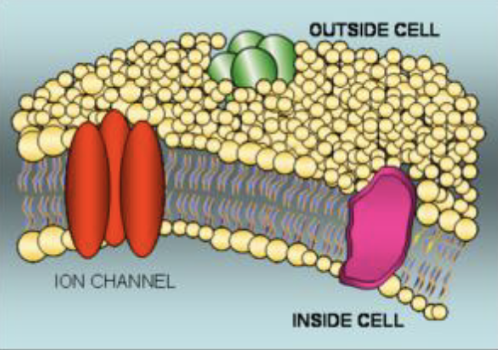
Neuron
send and receive electrical impulses over a long distance by transmitting signals through synapses.
Glial Cells
support and protect neurons, maintain homeostasis, and facilitate communication in the nervous system.
2 types of cells in Nervous System
neurons
glial cells
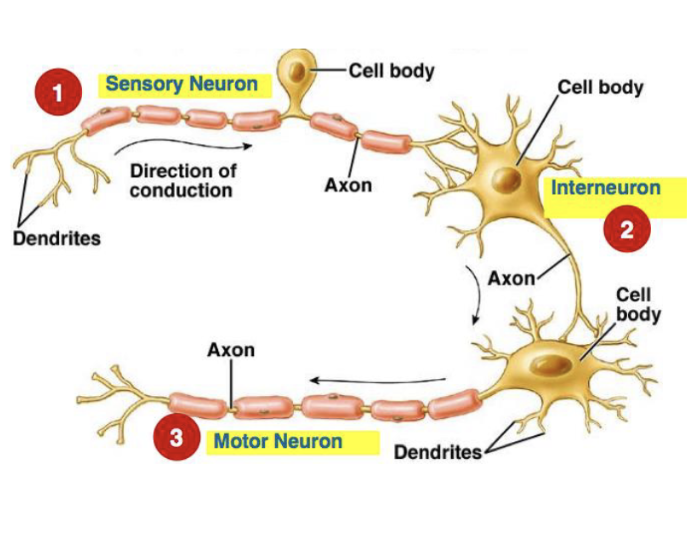
Sensory Neuorns
detect stimuli from the environment and convert them into neural signals.
starting man
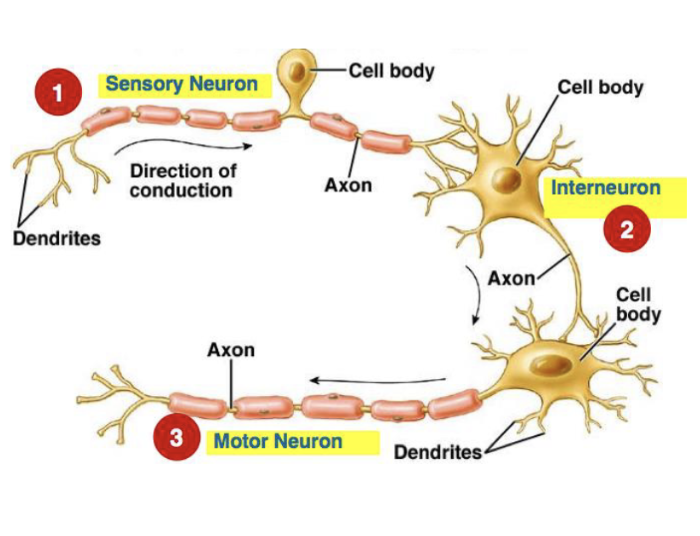
Interneurons
connect sensory and motor neurons within the central nervous system.
acts as a middleman

Motor Neurons
transmit signals from the central nervous system to muscles and glands, facilitating movement.
makes you react
If someone pinches your skin, motor neurons carry the signal to your muscles to withdraw.
Types of Glial Cells
Microglia
Oligodendrites
Schwann cells
Astrocytes
Ependymal Cells

3 types of Neurons
sensory neurons
interneurons
motor neurons
What is the function of microglia?
fight infections and remove debris in the nervous system
What is the function of Oligodendrites and Schwann cells?
to form myelin sheaths around axons in the central and peripheral nervous systems, respectively.
oligodendrites handle myelination in the central nervous system
Schwann cells handle myelination in the peripheral nervous system.
What is the function of the astrocytes?
to support and maintain the blood-brain barrier, regulate blood flow, and assist in neurotransmitter recycling in the nervous system.
What is the function of Ependymal Cells?
specialized, ciliated epthithelial cells filled with cerebrospinal fluid
Cell Body
the part of a neuron that contains the nucleus and organelles, responsible for maintaining the cell's life.
What are the 2 types of neural processes?
dendrites, which receives signals
axons, which transmits signals that conduct electrical impulses away from the cell body.
What is the synapse?
The junction where a neuron communicates with another cell (neuron, muscle, or gland).
What is the axoplasm?
cytosol within an axon
Nodes of Ranvier
gaps in the myelin sheath of an axon that facilitate faster signal conduction.
Cells at rest normally have
excess negative charge on the inside
excess positive charge on the outside
What is resting membrane potential?
is the electrical charge difference across a neuron's membrane when it is not actively sending signals, typically around -70 mV.
What ion serves at the countering for trapped anions inside cell
Potassium (K+)
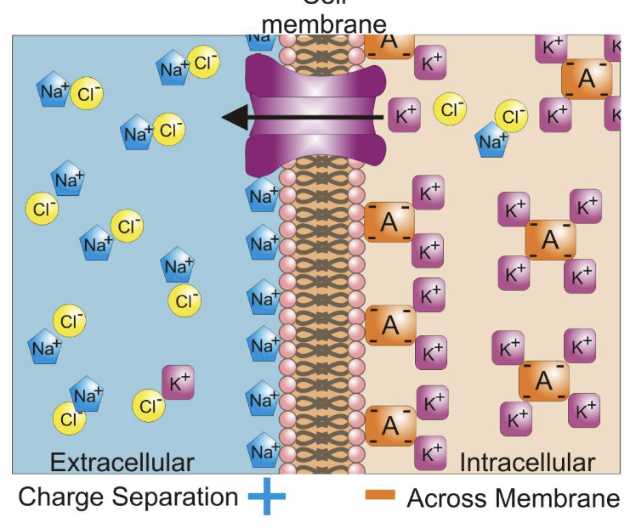
What is the potassium ion concentration gradient
uneven distributuion of high concentration of sodium ions inside and low concentration of potassium ions outside
What serves as a counterion for anions trapped outside cell?
Cl- is the countering with Na+ as the main cation
2 types of ion channels
leak channels
Na+/K+ pump
what do leak channels do?
ion channels that are always open, allowing passive diffusion of ions
What do potassium leak channels do?
allow K+ to diffuse out of the cell, which leaves many anions without their counter ions, this results in negative resting membrane potential
What does the Na+/K+ pump do?
continually pumps 3 sodium ions out of cell and 2 potassium ions into the cell, maintaining the resting membrane potential a
What is depolarization?
a decrease in membrane potential when Na+ enters cell, making it more positive
What is hyperpolarization?
when too much K+ leaves cell, making membrane potential more negative than resting state
What are voltage gated channels?
proteins that open or close in response to changes in membrane potential, allowing ions to flow across the membrane.
all or nothing, either these channels open fully or they’re closed
voltage-gated potassium channels and voltage gated sodium channels
What is propagation?
The movement of action potentials along the axon, allowing signals to travel quickly and efficiently from one part of the neuron to another.
What initiates an action potential?
depolarization rwching the threshold potential, leading to Na+ influx
What happens during repolarization?
Voltage-Gated Na+ channels inactivate, and K+ channels open, allowing K+ to leave the cell.
What is the absolute refractory period?
The period when Na+ channels are inactivated, preventing another action potential.
no firing occurs
what is the relative refractory period?
A period when an action potential can occur, but only with a stronger-than-normal stimulus.
firing is not likely but MAY occur
Resting state
<span>The state of a neuron when it is not actively transmitting an action potential, characterized by a stable membrane potential, typically around -70mV, with closed Na+ channels and open K+ channels.
voltage dependent channels are usually closed
cell is 100 times more permeable to K+ than to Na+
Subthreshold depolarization
A small depolarization of the membrane potential that does not reach the threshold to trigger an action potential.</span>
Depolarization phase
membrane potential becomes less negative
voltage gated Na+ channels open
and Na+ ions flow into the cell, resulting in a rapid increase in membrane potential.
Repolarization Phase
starts to return to negative membrane potential
Na+ channels inactivate → shuts down Na+ influx
K+ channels open → K+ efflux
Hyperpolarization phase
membrane potential becomes more negative than resting potential
too much K+ leaving the cell
What is saltatory conduction?
Action potentials jump between nodes of Ranvier in myelinated axons, increasing speed.
How are action potentials propagated along the axon without losing strength?
Depolarization spreads passively but decreases in magnitude
to travel farther, action potentials must be actively regenerated along the membrane
Where are action potentials most easily generated?
at the axon hillock, where incoming signals depolarize the dendrites and spread passively
Action Potential in a Nonmyelinated nerve cell
An electrical signal that travels without the presence of myelin sheath, where action potentials are regenerated at each point along the membrane.
has to go through entire axon without stopping
Action Potential in a myelinated cell
An electrical signal that travels rapidly along the axon due to the presence of myelin sheath, where action potentials are generated at the Nodes of Ranvier, allowing for saltatory conduction (jumps from node to node), increasing the speed of conduction and conserving energy.
faster propagation
Paranodal Regions
adjacent nodes where axonal and glial cell membranes have specialized adhesive proteins
Juxtaparanodal regions
next to paranoids where K+ channels are highly concentrated
How does depolarization spread along axon?
spreads passively to adjacent regions, but magnitude decreases over distance unless regenerated
What must happen for an action potential to travel farther along the axon?
must be propagated or actively generated along membrane
How does saltatory propagation differ from continuous propagation?
saltatory propogation causes action potential to jump from one node of ranvier to the next, compared to continuous propagation, which is slower and less powerful.
what is the difference between electrical and chemical synapses?
electrical synapses use gap junctions to connect adjacent neurons, allowing for direct ionic current flow, while chemical synapses involve the release of neurotransmitters into the synaptic cleft.
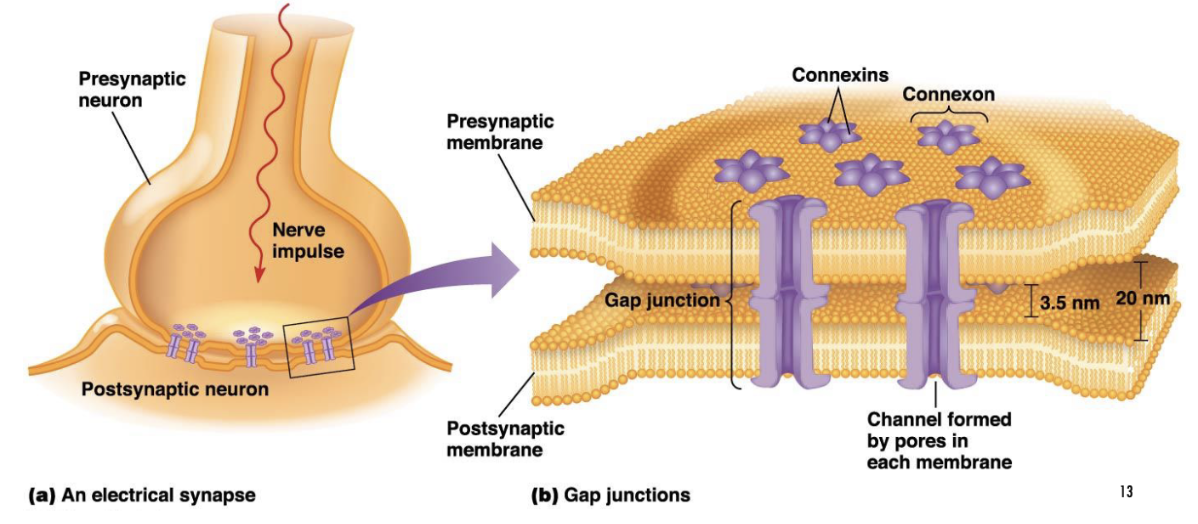
Electrical synapses
presynaptic and post synaptic neurons are connected via gap junctions
ions move through junctions without delays
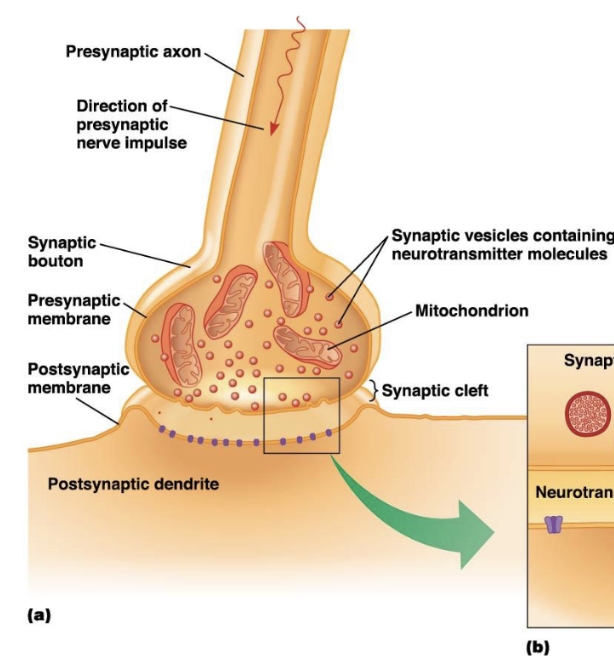
Chemical synapses
are not connected by gap junctions
separated by synaptic cleft
terminus of the presynaptic neuron must be sent to the postsynaptic neuron chemically
what are neurotransmitters and what is their role in signaling?
chemical messengers released by neurons to transmit signals across the synaptic cleft to other neurons
where are neurotransmitters found?
stored in the synaptic bouton within the synaptic cleft within the presynaptic neuron
What triggers neurotransmitter secretion at the presynaptic terminal?
arrival of action potential
excitatory receptors…
cause depolarization of the postsynaptic neuron
more likely for action potential to fire
inhibitory receptors..
cause postsynaptic cell to hyperpolarize
less likely for action potential to fire
what is calcium’s role in the release of neurotransmitters?
depolarization causes a temporary increase in Ca2+ due to opening of voltage gated calcium channels
which triggers exocytosis of neurotransmitters from synaptic vesicles.
NT fuses with plasma membrane and releasesneurotransmitters into the synaptic cleft.
What proteins mediate vesicle fusion with presynaptic membrane?
t-SNARE and v-SNARE proteins
t-SNARE → presynaptic membrane
v-SNARE → synaptic vesicle
mediate the docking and fusion of synaptic vesicles with the presynaptic membrane, facilitating neurotransmitter release into the synaptic cleft.
What is the role of synaptotagmin in neurotransmitter release?
a Ca²⁺ sensor that triggers SNARE complex activity, promoting vesicle fusion and neurotransmitter exocytosis.
where does docking take place?
active zone, where synaptic vesicles and calcium channels are very close together
what is compensatory endocytosis?
The process by which synaptic vesicle membrane is retrieved after neurotransmitter release, ensuring vesicle availability for future exocytosis.
endocytosis replenishes for future exocytosis
what is kiss and run exocytosis?
A vesicle briefly fuses with the membrane, releases some neurotransmitter, then reseals and returns to the cytoplasm.
types of neurotransmitter receptors
ligand-gated ion channels (ionotropic receptors)
metabotropic receptors (exerts effects via secondary messengers)
What type of receptor is the nicotinic acetylcholine receptor (nAchR)?
ligand-gated Na+ channel that allows Na+ influx after acetylcholine binding, causing depolarization
What happens when GABA binds to its receptor?
GABA receptor is a ligand-gated Cl⁻ channel that allows Cl⁻ to enter, causing hyperpolarization and making an action potential less likely.
What ion(s) does the NMDA receptor allow to pass?
one of several iontropic receptors, which allows Na
What are antagonists?
substances that compete with normal NTs for binding its receptor and preventing depolarization (action potential)
Acetylcholine antagonists
snake venoms
eg - neurotoxins a-bungarotoxin and cobratoxin
NMDA antagonists
often used as anesthetics as they inhibit the NMDA receptor and prevent excitatory signaling in the brain.
Agonists
bind to the receptor and cause depolarization. enhance NT activity
cannot be rapidly inactivated
why do neurotransmitters have to be inactivated shortly after their release?
to prevent abnormally prolonged stimulation or inhibition of postsynaptic neuron
3 ways neurotransmitters can be inactivated after their release
Reuptake → NT is taken back into presynaptic neuron or nearby glial cells
Degradation → Specific enzymes break down neurotransmitters into inactive components
Diffusion → NTs move out of synaptic cleft
what is temporal summation?
effect of multiple EPSPs that add up over time, which then reaches a threshold and action potential occurs
spatial summation
multiple EPSPs occurring simultaneously at different locations on the neuron's membrane, leading to the potential for an action potential.
What are the three catecholamines, and where are they synthesized?
Dopamine, norepinephrine, and epinephrine; synthesized in the adrenal gland
What is the most common neurotransmitter in vertebrates and an excitatory neurotransmitter in cholinergic synapses?
Acetylcholine
Name three neurotransmitters that are amino acids or their derivatives.
Histamine, serotonin, and GABA
What are endocannabinoids, and what is an example?
Lipid derivatives that inhibit presynaptic neurons; example: THC in cannabis